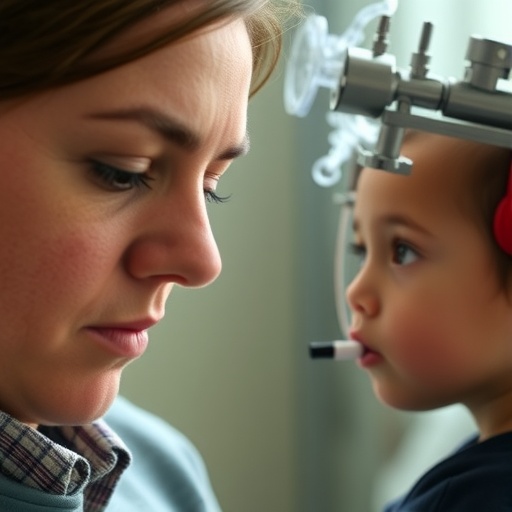A groundbreaking large-scale genetic study has unveiled novel insights into the underlying biology of strabismus, a common ocular condition affecting millions worldwide. This condition, characterized by the misalignment of the eyes, often leads to impaired stereoscopic vision and can cause amblyopia if left untreated. Historically, the precise genetic underpinnings of strabismus have remained elusive, posing challenges for both diagnosis and therapeutic development. However, this new research, conducted by He et al. and published in Nature Communications, harnesses the power of genome-wide association studies (GWAS) to illuminate key genetic loci associated with strabismus. The findings not only identify specific risk regions in the genome but intriguing also highlight a possible link between these genetic factors and maternal smoking during pregnancy, offering compelling evidence of environmental-genetic interplay in the etiology of this visual disorder.
Strabismus, colloquially known as “crossed eyes” or “wandering eyes,” represents a complex condition where the eyes fail to align properly on a focal point. While environmental factors and neurological dysfunction have long been implicated, uncovering the genetic basis provides a deeper understanding of whose risk can be inherited and how gene-environment interactions may exacerbate or mitigate disease development. The study by He and colleagues leverages one of the largest cohorts ever assembled for this condition, involving tens of thousands of individuals, to perform a genome-wide scan that reveals associations between single nucleotide polymorphisms (SNPs) and the presence of strabismus. This scale of investigation marks a significant leap beyond prior reports, offering unprecedented resolution in mapping the genetic architecture of eye alignment disorders.
The research team meticulously gathered genomic data from diverse populations, employing rigorous phenotypic characterization to differentiate strabismus subtypes and control for confounding variables. The comprehensive data allowed researchers to identify not just a handful, but multiple loci significantly correlated with increased risk of strabismus. Astonishingly, some of these loci lie near genes already implicated in neural development and eye muscle function, areas known to be critical in coordinating binocular vision. Their identification underscores the biological plausibility of these genetic variants as contributors to pathogenesis rather than mere markers, opening avenues for targeted functional studies to explore mechanistic pathways leading to ocular misalignment.
.adsslot_Ew0DmnfW8S{ width:728px !important; height:90px !important; }
@media (max-width:1199px) { .adsslot_Ew0DmnfW8S{ width:468px !important; height:60px !important; } }
@media (max-width:767px) { .adsslot_Ew0DmnfW8S{ width:320px !important; height:50px !important; } }
ADVERTISEMENT
Among the notable discoveries is the emergence of a cluster of risk loci on chromosomes that harbor genes relevant to synaptic connectivity and neuromuscular signaling. These genes likely influence the complex neural circuitry that orchestrates eye movement and coordination between ocular muscles. Strabismus has long been hypothesized to stem from disruptions in these neuro-muscular pathways, but definitive genetic corroboration had been missing until now. With GWAS uncovering these genomic hotspots, researchers can now delve deeper into how specific genetic variations alter protein function or expression patterns, potentially disrupting the delicate balance required for binocular alignment from infancy through adulthood.
Beyond the direct genetic revelations, this extensive GWAS also shed light on a fascinating and previously underappreciated environmental factor: maternal smoking during pregnancy. By integrating genetic data with well-curated maternal behavioral histories, the study provides robust statistical evidence supporting an interaction between maternal smoking exposure and the genetic risk of strabismus development in offspring. This finding amplifies the longstanding calls for rigorous public health measures to discourage smoking during pregnancy, as it appears to contribute not just broadly to developmental defects, but specifically to ocular alignment disorders. The mechanistic nexus between smoking-induced prenatal environmental stressors and genetically predisposed neurodevelopmental pathways presents a rich landscape for future inquiry.
Maternal smoking has been linked to various adverse birth outcomes, but its particular association with strabismus highlights how prenatal environmental toxins may epigenetically or developmentally prime vulnerable gene networks. Nicotine and related chemical compounds are known to interfere with embryonic neural growth and vascular development, which may disrupt the fine-tuned programming needed for controlling eye muscle innervation. This new research strengthens the hypothesis that gene-environment dynamics are paramount in determining ultimately who develops strabismus, yielding crucial insights that behavioral modification during pregnancy could ameliorate genetic risk, potentially reducing disease burden in future generations.
Technologically, the study capitalized on advanced GWAS methodologies, combining high-density genotyping arrays with sophisticated statistical models that account for population stratification and linkage disequilibrium. This ensures that the identified loci truly represent significant signals rather than confounded artifacts. The robustness of the dataset enabled the fine-mapping of risk variants and prioritized several candidate genes for functional follow-up. Importantly, the large sample size equipped the researchers with the power to detect modest effect sizes, illuminating the polygenic nature of strabismus risk—a hallmark of most complex traits influenced by numerous genetic and non-genetic factors.
This genetic architecture emphasizes that strabismus is not merely a monogenic or sporadic condition but rather the interplay of multiple risk alleles, each incrementally tipping the scales toward disease when combined with environmental triggers like prenatal smoking exposure. Dissecting this complex biological puzzle requires an interdisciplinary approach that spans genomics, developmental biology, ophthalmology, and epidemiology. The new GWAS findings provide the foundational genetic map from which translational studies can emerge, including efforts to uncover biomarkers for early detection, prognosis, and perhaps even gene-targeted therapy or preventive interventions in high-risk populations.
The clinical implications of this research are profound, particularly for pediatric ophthalmology. Early identification of children genetically predisposed to strabismus may inform surveillance strategies, prompt timely corrective treatments such as vision therapy or surgical intervention, and ultimately minimize the long-term consequences of untreated ocular misalignment. Moreover, understanding the genetic basis informs counseling for affected families, shedding light on inherited risk patterns and potentially guiding reproductive decisions. Such resources add invaluable depth to clinical management frameworks that have traditionally relied on phenotypic observation rather than molecular diagnostics.
This study also energizes prospects for drug discovery. Given that several implicated genes influence neurotransmission and neuromuscular interaction, modulating these pathways pharmacologically could correct or mitigate functional deficits before structural maladaptations solidify. Novel therapeutics targeting synaptic plasticity or muscle innervation may therefore emerge from integrating these genomic insights with pharmacological innovation. Bridging the gap from genomic association to clinical application represents a promising frontier driven by data such as that provided by He and colleagues.
From a public health perspective, the reinforcement of maternal smoking as a modifiable risk factor amplifies the critical need for smoking cessation programs targeting expectant mothers. While genetic predisposition cannot be altered, environmental exposures clearly can, and this study sharpens the focus on prenatal care as a venue for strabismus risk reduction. Public health frameworks stand to benefit immensely by incorporating these insights into educational campaigns and preventive health policies, potentially decreasing the incidence of strabismus and its socioeconomic repercussions.
In the realm of basic science, the identified genetic loci provide a treasure trove of targets for further unraveling the molecular choreography responsible for ocular alignment. Experimental validation, including animal models and cellular assays, will be essential in confirming the roles of candidate genes and variants. Such studies will help define precise molecular mechanisms—whether through transcriptional regulation, protein interaction, or epigenetic modification—that drive aberrant eye muscle control. This mechanistic understanding remains key to translating genetic correlation into causation, a necessary step before effective therapeutic interventions can be crafted.
The integration of large-scale genetic data with environmental records typifies the “next generation” of complex disease research. By building models that encompass gene-environment interactions, this approach captures the multifaceted reality of human diseases like strabismus better than traditional single-factor studies. It emphasizes the importance of multidisciplinary consortia and large cohorts to generate statistically robust insights and ultimately transform patient care. The collaborative framework used in this investigation serves as a blueprint for future efforts in ocular genetics and beyond.
Subject of Research: Genetic and environmental factors contributing to the etiology of strabismus.
Article Title: Large-scale GWAS of strabismus identifies risk loci and provides support for a link with maternal smoking.
Article References:
He, W., van der Most, P.J., Ong, JS. et al. Large-scale GWAS of strabismus identifies risk loci and provides support for a link with maternal smoking. Nat Commun 16, 7890 (2025). https://doi.org/10.1038/s41467-025-62456-9
Image Credits: AI Generated
Tags: amblyopia risk factorsenvironmental-genetic interplayeye misalignment disordersgenetic loci associated with strabismusgenome-wide association studieshereditary aspects of strabismusmaternal smoking and eye healthocular condition researchpublic health and maternal behaviorsstrabismus genetic studytherapeutic development for strabismusvision impairment causes





